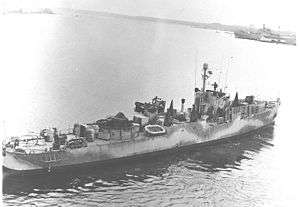USS PGM-10
USS PGM-10 was a PGM-9-class motor gunboat that was in service with the United States Navy during World War II, and transferred to the Philippine Navy shortly thereafter.
 Ship of same class, USS PGM-17 | |
| History | |
|---|---|
| Name: | PGM-10 |
| Builder: | Commercial Iron Works |
| Launched: | 27 October 1943 |
| Commissioned: | 29 November 1944 |
| Fate: | Transferred to the Philippines |
| General characteristics | |
| Displacement: | 280 tons (light), 450 tons (full) |
| Length: | 173 ft 8 in (52.93 m) |
| Beam: | 23 ft (7.0 m) |
| Draft: | 10 ft 10 in (3.30 m) |
| Propulsion: | Two 1,280 bhp (950 kW) Hooven-Owen-Rentschler RB-99 DA diesel engines |
| Speed: | 19 knots (35 km/h; 22 mph) |
| Complement: | 65 officers and enlisted |
| Armament: |
|
History
PGM-10 was laid down on 18 September 1943, as PC-805 by the Commercial Iron Works, in Portland, Oregon. After being launched on 27 October 1943, she was reclassified as PGM-10 in August 1944. On 29 November 1944, she was put into naval service as PGM-10.
On 5 January 1945, PGM-10 left San Pedro, California, for Pearl Harbor, Hawaii, and arrived outside Pearl Harbor 6 days later on 11 January 1945. Later, on 3 February 1945, she steamed for Eniwetok, escorting LSM's and LSI's. Along the journey, she passed within 15 miles of the Japanese-held Wotje Atoll, coming within sight of Kawajalin. She arrived at Eniwetok two days later on 14 February 1945, leaving once again two days later escorting 4 merchant ships and a navy tanker along with 2 other Patrol Craft as escorts.
PGM-10 would continue her duties in this fashion until 25 February 1945, when she began her first patrol duty. On 27 and 28 February 1945, she shelled a Japanese Radio Installation. By May 1945, she had four shot down Japanese planes to her credit.
Typhoon Louise
Like the ill-fated PGM-9, her sister, PGM-10, was also present for Typhoon Louise. A deck log is as follows:
"17 OCT 1945. ARRIVED OKINAWA. LARGE NUMBER OF OUR SHIPS ON REEF DUE TO TYPHOON. PGM 9 IS ON REEF. TIDAL WAVE WASHED AWAY ATOLL OF ENAWETOK."
Ship's fate
In October 1948, the ship was transferred to the State Department, Foreign Liquidation Commission.[3] Little is known about the ships post-war life, only that she was transferred to the Philippine Navy after late 1948.
References
- page 3; Naval Source online; accessed October 2015
External links
- Unofficial Crew Log, 5 January 1945 – 7 December 1945- NavSource-PGM-10
- PGM-10 Crew Photo Gallery- NavSource-PGM-10
- U-Boat.net, U.S.S. PGM-10- uboat.net- PGM-10